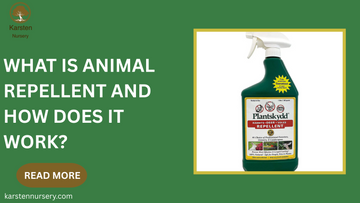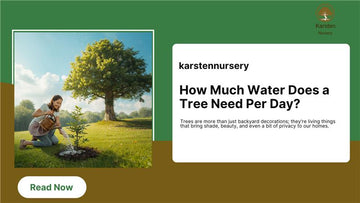
A beautiful garden is a labor of love. You’ve carefully selected your plants, nurtured the soil, and patiently waited for blooms and harvests. So, it’s incredibly frustrating to discover that local wildlife views your garden as their personal buffet. From nibbled leaves to dug-up bulbs, animal damage can be disheartening. This is where a strategic defense, often in the form of an animal repellent, becomes a gardener's best friend.
At Karsten Nursery, we understand the delicate balance between cultivating a thriving ecosystem and protecting your prized plants. This guide will walk you through what animal repellent is, how it works, and how to choose the right one for your garden sanctuary.
What Exactly Is Animal Repellent?
An animal repellent is any substance or device designed to keep unwanted wildlife from entering a specific area, like your yard or garden. The principle is not to harm the animals but to persuade them to seek food and shelter elsewhere. Think of it as creating an invisible "keep out" sign that animals understand.
These solutions range from simple homemade sprays to sophisticated electronic devices. The best choice for you depends on the type of pest, the size of your area, and your gardening activities.
How Does Animal Repellent Work? The Science of Deterrence
Animal repellents work by targeting one or more of an animal's primary senses: taste, smell, hearing, or sight. By creating an unpleasant or frightening experience, they condition animals to avoid the area.
1. Scent-Based Repellents
This is one of the most common categories. These repellents use strong, offensive odors that animals associate with danger or spoiled food.
-
Predator Urine: Products use coyote, fox, or bobcat urine to trigger a primal fear response in prey animals like rabbits and deer. The scent signals that a predator is nearby.
-
Putrescent Egg Solids: This ingredient smells like rotting eggs or decaying flesh to animals. Creatures like deer, squirrels, and raccoons instinctively avoid it, associating the smell with disease and inedible food.
-
Garlic and Capsaicin: Spicy and pungent smells are irritating to animals' sensitive noses and taste buds. This forms the basis of many natural animal repellent sprays.
-
Commercial Sprays: Products like Plantskydd animal repellent use a combination of these scent principles to create a long-lasting, weather-resistant barrier.
2. Taste-Based Repellents
These products are applied directly to plants, flowers, and bark. They are harmless to the plant but leave a bitter, spicy, or otherwise awful taste that discourages animals from taking a second bite.
-
How they work: A deer might take one bite of a treated hosta, find it incredibly unpleasant, and learn to avoid that plant, and often others nearby, in the future.
-
Common ingredients: Capsaicin (from hot peppers), garlic, and bittering agents are common in these formulas, making them an effective animal repellent for plants.
3. Ultrasonic Repellents
These electronic devices, also known as outdoor animal repeller units, emit high-frequency sound waves that are inaudible to most humans but highly irritating to pests such as dogs, cats, rodents, and rabbits.
-
Motion-Activated: Many modern ultrasonic repeller devices are motion-activated deterrents. They remain silent until an animal enters their detection field, then they emit a sudden ultrasonic tone, startling the animal and encouraging it to flee.
-
Effectiveness: Their efficacy can vary based on the terrain (sound doesn't travel well through solid objects) and the specific animal species.
4. Visual and Physical Deterrents
This category includes a wide range of tools that scare animals or create an uncomfortable physical barrier.
-
Motion-Activated Lights and Sprinklers: A sudden blast of light or water startles animals and conditions them to avoid the area. This is a highly humane animal control method.
-
Reflective Tape and Scarecrows: Flashing, moving objects can confuse and scare birds and some mammals away.
-
Physical Barriers: While not a "repellent" in the traditional sense, fencing is the most effective physical barrier. For smaller plants, netting or cloches provide excellent garden pest protection.
Read more blog: What is the size of a lilac?
Choosing the Best Animal Repellent for Your Needs

With so many options, how do you select the right one? Ask yourself these questions:
-
What pest are you dealing with? Identify the culprit. Deer require a different deterrent than burrowing rodents or digging dogs.
-
Deer/Rabbits: Scent and taste-based sprays are highly effective.
-
Squirrels/Chipmunks: Taste sprays, ultrasonic devices, and physical barriers work well.
-
Raccoons/Opossums: Strong scent-based wildlife deterrent spray and secure trash cans are key.
-
Cats/Dogs: Ultrasonic repeller devices and animal deterrent spray designed for pets are best.
-
What is your garden environment? Is it a large property, a small urban plot, or a container garden on a balcony? Large areas may benefit from multiple ultrasonic or motion-activated deterrents, while a small flower bed might only need a targeted spray.
-
Do you have pets or children? If so, you’ll want to prioritize safe repellent for pets and children. Look for natural and eco-friendly pest deterrent options that use ingredients like garlic and capsaicin, and always follow label instructions for application.
-
What is your philosophy? Are you looking for the most powerful solution regardless of type, or do you prefer a natural animal repellent or humane animal control method?
For many gardeners, a combination of types of animal repellents, a strategy called layering, is the most effective approach. For example, you might use a taste-based spray on your plants and install an ultrasonic repeller at the edge of your garden.
Natural Solutions: Plants as Deterrents

A clever form of garden animal repellent is using nature itself. Interspersing certain plants that animals find unappealing can help protect more vulnerable ones. This is the concept behind plant animal repellent strategies.
Consider planting these around your garden's perimeter:
-
Deer-resistant: Lavender, Marigolds, Russian Sage, Mint
-
Rabbit-resistant: Alliums, Salvia, Catmint, Snapdragons
While not foolproof, using plants that repel animals is an excellent, passive, and beautiful way to enhance your garden’s defenses.
Final Thoughts
Understanding how animal repellent works empowers you to protect your garden effectively and humanely. The goal isn't to wage war on local wildlife but to guide them toward more natural food sources and away from your cultivated plants.
At Karsten Nursery, we believe every gardener deserves to enjoy the fruits (and flowers) of their labor. Our experts are here to help you diagnose pest problems and recommend the most effective and appropriate solutions for your unique landscape. From the best animal repellent for gardens to advice on garden pest protection, we have the knowledge and products to help your garden thrive.
Visit Karsten Nursery today, and let us help you choose the right defense to keep your garden beautiful, bountiful, and animal-free.
FAQs
Q1. Do animal repellents really work?
Yes, when selected and applied correctly for the target pest. Consistency and reapplication (especially after rain for sprays) are key to long-term success.
Q2. How long does animal repellent last?
It varies. Scent and taste-based sprays generally last 2-4 weeks before needing reapplication, depending on the weather. Granular repellents may last longer. Electronic devices last as long as their power source.
Q3. Is animal repellent safe for your plants and pets?
Many commercial repellents, especially natural and eco-friendly options, are safe for plants when used as directed. For pet safety, always check the product label.
Q4. What is the best animal repellent for gardens?
There is no single "best" option, as it depends on the animal. For general use against deer and rabbits, a scent and taste-based spray like Plantskydd is a top-rated and highly effective choice.
Q5. How do you make homemade animal repellent?
A common recipe involves mixing water, a few drops of biodegradable dish soap (to make it stick), and a potent ingredient like crushed garlic, cayenne pepper, or vinegar. Strain and spray.
Read More Blog:





